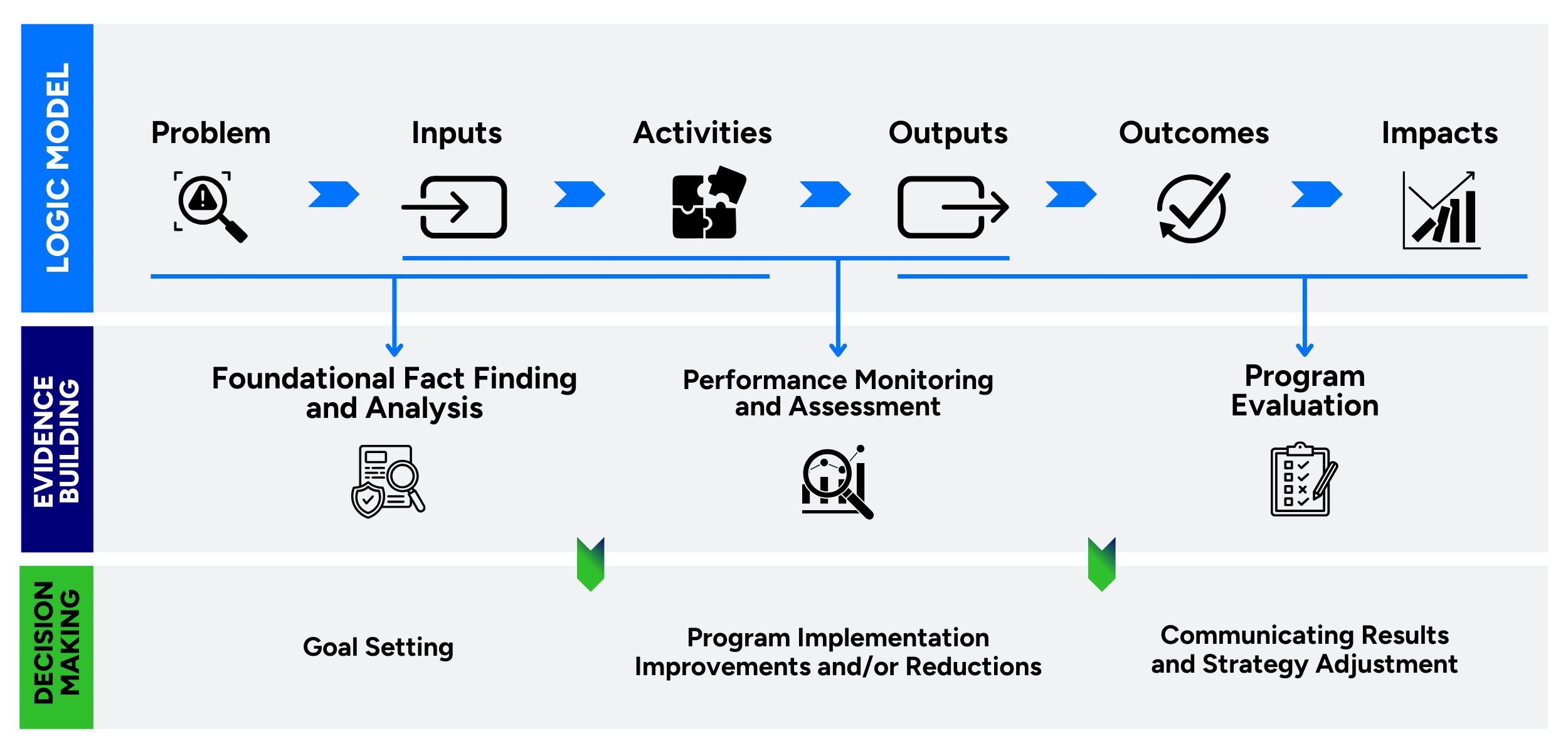The Office of Energy Efficiency and Renewable Energy's (EERE) Metrics, Measures, and Evaluation (MME) team conducts program evaluations to assess the impact of EERE's programs and research and development (R&D) activities, helping to ensure efficient management of public investments and continuously improving the effectiveness of programs. These ongoing efforts hold EERE's work to the highest standards of independence, transparency, and quality.
The MME team upholds an organizational culture of documenting theories of change and performance indicators at the outset of activities, while seeking opportunities to answer strategic questions through evaluation and proactively collecting necessary data. For more details on EERE's evaluation approach and goals, please download the Evaluation Guidance document. Federal guidance from the Office of Management and Budget (OMB) is also available.
EERE's Logic Model and Theory of Change
A logic model documents how a program is intended to work. It maps out the relationship between the resources required to implement a program, the details of activities and outputs of the program, and the desired sequence of outcomes and longer-term impacts. The theory of change explains the causal effect of how a program's execution is expected to progressively affect its goal. Logic models and theories of change are important guides for program scoping and design, strategic and operational planning, identifying pathways to results, developing metrics for use in evaluation, and formulating evaluation questions.

Performance and Evaluation Activities
EERE uses various types of evaluation to quantify impacts, assess progress, and promote improvement. The type of evaluations performed depend on the required evidence and questions that need to be answered, including a consideration of questions that are expected to help provide the organization or program with evidence it can use to improve how it does business. The types of evaluations listed below are in the approximate order of when they would be conducted in the program life cycle (before, during, and after the program runs).
| Type of Performance and Evaluation Activity | Description | Samples of Prior Evidence |
|---|---|---|
| Cost Benefit Evaluations | A specialized type of impact evaluation that determines the "realized" economic benefits and costs of Research & Development (R&D) and technology deployment programs using discounted cash flow analysis. | Benefit-Cost Evaluation of U.S. Department of Energy Investment in HVAC, Water Heating, and Appliance Technologies (2017) |
| Impact Evaluations | Used to document whether a program is achieving its goals and assess why or why not. Quantifies the extent to which outcomes can be attributed to a program intervention by establishing causality. | Saving Energy, Building Skills Industrial Assessment Centers Impact (2022) |
| Market Needs and Effects Assessments | Measures aspects of supply chain and market infrastructure or structure that could affect the development and adoption of technologies. These assessments provide information about the baseline of current practices and behaviors of market entities and are usually conducted prior to initiation of new projects or programs. | Advanced Sensors and Controls for Building Applications: Market Assessment and Potential R&D Pathways (2005) |
| Merit Reviews | Provides an independent assessment of the technical or scientific merit of applications for projects that are being proposed before they are implemented. These reviews include an objective and quantitative rating system. Results of Merit Reviews are confidential and not subject to public information records requests. | Not applicable |
| Outcome Evaluations | Measures outputs and outcomes (including unintended effects) to judge program effectiveness. This type of evaluation determines change in outcomes for specified metrics, but without establishing causality or rigorous counterfactuals. | Saving Energy, Building Skills Industrial Assessment Centers Impact (2022). |
| Peer Reviews | Peer reviews are a form of process evaluation, also referred to as peer evaluation. They seek to answer questions of how well an activity is being implemented and how to make improvements. They can cover an individual project or whole portfolios and are often conducted with a focus on in-process projects, but they can also be implemented for activities that have been recently completed. | Water Power Program Peer Reviews (2009-2022) |
| Process Evaluations | Periodic assessments of a program's progress, including process implementation studies to determine where and how to make improvements, improve efficiencies, and ensure that the program is running as planned. | Analysis of the U.S. Department of Energy's Energy Efficiency & Renewable Energy and Fossil Energy SBIR Programs (2019) |
| Project and Portfolio Performance Metrics | Quantitative measurements used to assess the performance of projects or larger portfolios of projects that are established prior to the initiation of activities. These metrics help stakeholders evaluate the overall effectiveness of their project portfolio throughout the life cycle; they are measurable, outcome-based, clearly defined, and transparent to stakeholders. | Quarterly measures and yearly targets reported for the Government Performance and Results Act (GPRA) (2025) |
| Stage-Gate or Go/No-Go Reviews | A specific form of process evaluation that is conducted one or multiple times during a project's life cycle. It requires that specific technical targets or milestones are met and documented and that affirmative decisions are made to continue the project. | Materials Down Select Decisions Made Within DOE's Chemical Hydrogen Storage Center of Excellence (2009) |

